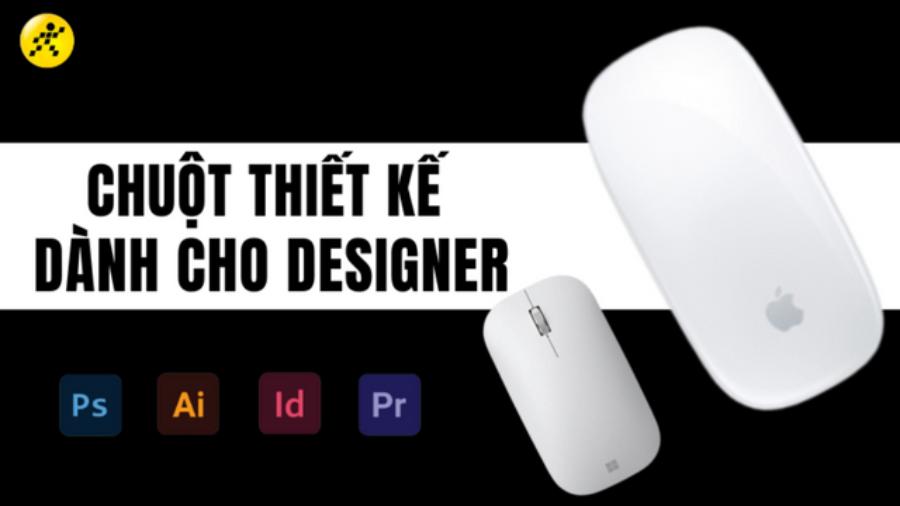Best Selling Products
Mouse Selection Tips for Designers: A to Z Guide
Nội dung
- 1. Why is Choosing the Right Mouse Important for Designers?
- 2. Important Factors When Choosing a Mouse for Designers
- 2.1. Sensor Accuracy and Response (DPI)
- 2.2. Ergonomics
- 2.3. Mouse Size and Shape
- 2.4. Button Features
- 2.5. Connection Technology: Wired or Wireless?
- 2.6 Number of buttons
- 2.7. Material
- 2.8. Brand and price
- 3. Popular Mouse Brands for Designers
- 3.1. Logitech
- 3.2. Razer
- 3.3. Wacom
- 4. Advice for Designers
- 5. Conclusion
Choosing a mouse for designers is an important factor that affects work efficiency. Learn the notes when choosing the right mouse, from grip feeling, accuracy, to additional features to improve design performance.

For a designer, choosing the right working tool does not stop at design software but also includes peripheral devices such as the mouse. The computer mouse is an indispensable tool, playing an important role in optimizing speed and accuracy when performing design operations. However, not all mice are suitable for graphic design work, especially when you have to spend many hours working on the computer. This article sadesign will help you better understand the factors to consider when choosing a mouse for designers, helping to improve work efficiency and protect your health throughout the creative process.
1. Why is Choosing the Right Mouse Important for Designers?
During the working process, a designer has to perform many detailed operations that require high precision. The mouse is a tool that helps you easily control design software, adjust pixels, move objects, and manipulate other tools. If the mouse does not meet the requirements of accuracy, sensitivity, or comfort when used, the design work will become more difficult and tiring, thereby affecting the quality and performance of the work.
.jpg)
A good mouse not only helps minimize technical errors but also helps designers maintain comfort during long working hours, thereby protecting hand and wrist health from problems such as muscle tension, hand fatigue or carpal tunnel syndrome.
A good mouse will bring the following benefits to the designer:
Increased accuracy : A good mouse helps designers move the mouse pointer more accurately, thereby increasing accuracy in design work.
Increase work speed : A good mouse helps designers work faster, save time and increase productivity.
Reduce hand fatigue : Good mice have an ergonomic design, which helps reduce hand fatigue when used for long periods of time.
Health Protection : A good mouse helps reduce the risk of wrist and shoulder diseases.
2. Important Factors When Choosing a Mouse for Designers
When choosing a mouse, factors such as accuracy, design, feel, and additional features will determine whether the mouse is suitable for your work needs. Here are some important factors to consider when choosing a mouse for graphic design work.
2.1. Sensor Accuracy and Response (DPI)
Accuracy is the first important factor that designers need to pay attention to. To be able to work accurately, especially when editing photos or designing details, the mouse needs to have a high resolution, expressed through the DPI (dots per inch) index. A mouse with a high DPI will help you move the cursor more smoothly and accurately, especially when you work with detailed tools like the Pen Tool in Adobe Illustrator.
A mouse with a flexible DPI adjustment will be the ideal choice, allowing you to easily change the mouse's response level to suit each task. For example, when drawing detailed vectors, you need a low DPI to precisely control each line, while when doing basic tasks, a high DPI will help you move quickly.
.jpg)
Specific sensor types:
Optical Sensor : Optical sensors are the most common type of sensor, which works by using LED light to detect mouse movement.
Laser sensor : Laser sensor has higher accuracy than optical sensor, can work on many different surfaces.
Which sensor should designers choose? Designers should prioritize choosing a mouse with a laser sensor to ensure accuracy and flexibility when using.
2.2. Ergonomics
Since designers often work with a mouse for long hours, choosing an ergonomic mouse is important to minimize stress on the wrists and fingers. Ergonomic mice help maintain comfort during long periods of use, reducing the risk of wrist problems such as Carpal Tunnel Syndrome.
A mouse that is comfortable and fits your hand will help you avoid pain or discomfort when using it for a long time. Choosing a mouse with a soft surface, easy to grip and not causing too much friction is essential.
2.3. Mouse Size and Shape
The size and shape of your mouse also greatly affects how comfortable you feel when using it. A mouse that is too small can strain your hand, while a mouse that is too large can make it difficult to move. Choosing a mouse that is the right size for your hand is essential to minimizing fatigue.
.jpg)
In addition, the mouse has an ergonomic design, with concave areas for the thumb and little finger, which will help you feel more comfortable when working for long periods of time.
2.4. Button Features
Designer mice often come with additional programmable buttons. These buttons give you quick access to tools in your design software without having to move the mouse around too much. For example, some mice have buttons that let you switch between brush modes in Photoshop, or change tools in Illustrator without having to press keyboard shortcuts.
If you are a designer who loves to work quickly and save time, choose a mouse that has the ability to program these buttons.
2.5. Connection Technology: Wired or Wireless?
The connection technology between the mouse and the computer is also a factor you need to consider. Wired mice usually provide a stable and uninterrupted signal, which is especially important when you work with software that requires high precision.
However, wireless mice offer convenience and comfort when used, allowing you to move more freely without having to worry about wires. If you choose a wireless mouse, make sure the mouse has a stable Bluetooth connection or use a USB receiver to avoid losing connection during work.
2.6 Number of buttons
Basic Button Count : Basic mice typically have 2 buttons (left and right) and a scroll wheel.
Additional Buttons : Some mice come with additional buttons, which can be customized to perform different functions.
Do designers need more buttons? Designers may need more buttons if they use complex design software that requires a lot of operations.
2.7. Material
Common Material : The common material of mice is plastic.
Premium Materials : Some mice are made from higher quality materials like metal or rubber, which increases durability and grip.
2.8. Brand and price
Reputable brand : You should choose a mouse from reputable brands such as Logitech, Razer, Corsair, SteelSeries...
Reasonable price : The price of mice is very diverse, from a few hundred thousand to a few million dong. You should choose a mouse with a price that suits your budget and usage needs.
3. Popular Mouse Brands for Designers
When it comes to mice for designers, there are a few prominent brands that are widely used and appreciated for their quality and features that are suitable for graphic design work.
.jpg)
3.1. Logitech
Logitech is one of the most popular mouse brands for designers. Lines like the Logitech MX Master and Logitech G Pro are known for their ergonomic design, high precision, and extremely flexible customization features. They have programmable buttons and accurate DPI sensors, making them great for design work.
3.2. Razer
Razer is a well-known brand in the gaming hardware industry, but Razer mice are also popular among the design community thanks to their sophisticated design and powerful features. Mice like the Razer DeathAdder Elite and Razer Naga feature high-end sensors, good ergonomics, and flexible button programming.
3.3. Wacom
If you’re a designer who specializes in illustration or digital drawing, Wacom could be a great choice. While Wacom is best known for its drawing tablets, their mice are also highly regarded in the creative community. These devices offer smooth, precise, and incredibly versatile gestures.
4. Advice for Designers
When choosing a computer mouse, Designers should consider carefully to ensure this tool best meets work needs.
Try the mouse before you buy : If possible, try the mouse before you buy to make sure it fits your hand and suits your preferences. Prioritize mouse lines with high DPI sensitivity and customization capabilities, helping you to operate precisely on design software. The size and ergonomic design of the mouse are also important, especially if you work for long periods of time, to avoid hand fatigue and increase productivity.
Read reviews : Refer to reviews from people who have used the mouse for more information and experience.
Clean your mouse regularly : Clean your mouse regularly to ensure good performance and long life.
Additionally, additional features such as programmable buttons or stable wireless connectivity are also factors to consider. Finally, choose products from reputable brands to ensure quality and long-term durability.
5. Conclusion
Choosing a mouse for designers is not just about finding a cheap or eye-catching product. You need to carefully consider factors such as accuracy, grip, additional features and comfort when using. A suitable mouse will not only help you work more efficiently but also protect the health of your hands and wrists when working for long periods of time.












































